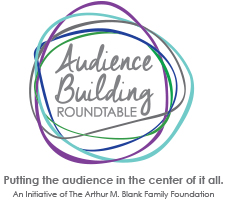Guest Blogger: Christopher R. Taylor, President, The Clay Studio, Philadelphia
Arts organizations need audiences. They bring earned and contributed revenue to your organization, and more importantly, they are an indicator of your success in fulfilling your mission. Whether you’re training young artists, presenting opera, displaying new paintings, or teaching art to children, your mission likely includes some version of “make arts accessible.” With finance and mission on the line, the task of building, sustaining, and expanding your audience is on par with your decisions about artistic quality and governance.
The results of the work at The Clay Studio, have been transformational in many ways. We have increased income and brought ceramic arts to more people. Along the way, we improved our relationship with our audiences, expanded our reach into the community, attracted new grant funding, and, perhaps most significantly, evolved in how we think about ourselves as an organization.
Diagnosis
The Wallace Foundation report, Road to Results, outlines Nine Effective Practices to building arts audiences. The Clay Studio utilized these methods in order to make positive changes in our audience building efforts. We began with feedback from focus groups, which provided new perspectives on how others perceived our organization and programs. Below are three examples of feedback that we received:
- We initially wanted to bring new audiences in through our gallery. Focus groups told us that people wanted to participate in the process of making as opposed to seeing or hearing about finished products.
- We produced brochures that featured beautiful ceramic work and used a tagline “Shaping the Future of Ceramics.” Focus groups said that the tagline was meaningless and that the imagery was not appealing enough to grab a brochure.
- Our class format of 10 weeks was, in our mind, a bare minimum to learn a new skill in ceramics. Focus groups told us that a $300 price tag and 10-week commitment was a steep first step.
Step-by-step information about conducting your own market research can be found in the Wallace companion workbook Taking Out the Guesswork.
Evolution isn’t Fast or Easy, but neither is Extinction.
Following the Road to Results format, steps five through seven are about synthesizing and adapting your organization to act upon the data you have gathered.
After gathering information on our audience, we could have folded our arms and shook our head with the justification that the audiences “just don’t get it.” Instead, the TCS staff developed short-term workshops, dropped the tag line altogether, and switched out images of pottery to show people having fun at a potter’s wheel. These changes represented genuine shifts in thinking about the entry points of our organization, visitor experience, and the face we put out to the world.
The introduction of one-day workshops, weekend seminars, and 5-week classes has yielded the largest return. We still have 10-week classes, but we switched our focus to introductory level experiences. In doing so, we lowered the barrier to participation. This has allowed more people to sample the process before deciding if they can commit to a longer class. We have tracked dozens of people who have progressed from single events into five-week and ten-week classes. It’s working.
There are plenty of questions to consider. Will you adapt? What do you know about your target audience? What aspects of your product could be adjusted to suit new audience interests? Are there non-mission related beliefs or behaviors that should be challenged? Do you have multiple entry points for a variety of interests?
Bring Your Arts Experience to More People. Remember That? It’s Called Your Mission.
Audience building is important to your institution. Take time to diagnose your problem, collect data, and respond to what you hear. The most difficult part is truly responding to the information and changing accordingly. If you are successful in diagnosis and adaptation, you’re likely to have positive shifts in attitude about your organization. These changes will allow you to bring your arts experience to more people. Remember that? It’s called your mission.
About Chris Taylor
Chris Taylor was appointed as the president of The Clay Studio in 2011. Prior to his arrival, TCS had completed significant audience research into the young professional demographic and had experimented with new program formats. Since his arrival, the organization has continued to adapt, experiment, and align the organization around a drive for new audiences. Results of this work can be found in the Wallace Foundation report Opening New Doors. Chris has presented audience development webinars and conference panels with the American Alliance of Museums and the Arthur Blank Foundation. He sits on the Advisory Board of the Arts and Business Council of Philadelphia and holds a BFA in Sculpture, a BA in Religious Studies, and a Masters of Arts Administration and Policy from the Art Institute of Chicago.
The Clay Studio Study: http://www.wallacefoundation.org/knowledge-center/audience-development-for-the-arts/strategies-for-expanding-audiences/Pages/Wallace-Studies-in-Building-Arts-Audiences-Opening-New-Doors.aspx
Wallace Study: http://www.wallacefoundation.org/knowledge-center/audience-development-for-the-arts/strategies-for-expanding-audiences/Pages/The-Road-to-Results-Effective-Practices-for-Building-Arts-Audiences.aspx
Wallace Guesswork: http://www.wallacefoundation.org/knowledge-center/audience-development-for-the-arts/strategies-for-expanding-audiences/Pages/Taking-Out-the-Guesswork.aspx
American Alliance of Museums: http://www.aam-us.org/
Arthur Blank Foundation: http://www.blankfoundation.org/
Arts and Business Council: http://www.artsandbusinessphila.org/
Art Institute of Chicago: http://www.saic.edu/academics/graduatedegrees/maaap/
Keywords; Wallace Foundation, "Road to Results", Focus Groups, Data, listening, adapting
